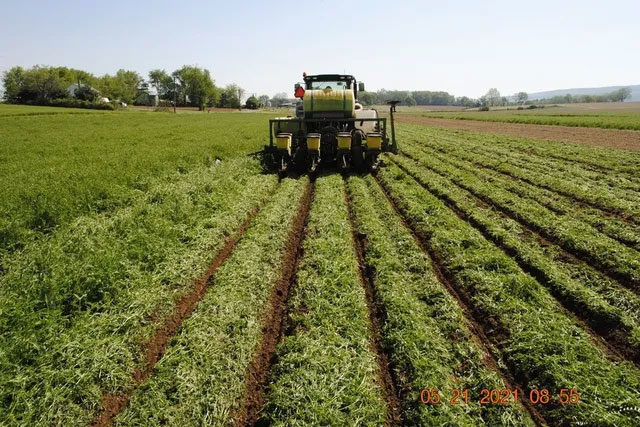Cool and muggy conditions make it extra important to pay attention to details for successful no-till planting. Problems one can run into are sidewall compaction and hairpinning of residue. Here are a few tips to avoid these problems:
- Over time, the soil in no-till becomes more forgiving due to higher soil organic matter content and soil tilth – this helps avoid smearing of soil in moist conditions. Therefore, use no-till continuously.
- Plant into soybean residue first – the soil under soybeans tends to have good tilth early but becomes hard later. Soil under soybean residue also tends to dry out before that under corn stover.
- To improve soil tilth, use a cover crop. This also helps to avoid problems with soil smearing.
- Plant through standing (cover) crop residue – mowing and shredding typically end up increasing planting problems because the residue is now loose and lying flat on the soil surface in different directions.
- Use planting green – if you still have the cover crop standing, it is now recommended to plant green into it instead of killing the cover and planting later. This is a change from our recommendations during dry spring conditions. The green cover will have transpired some soil water making it easier to plant through at this point.
- Make sure your planter is in good working order – planter units are tight, double disk openers have the proper diameter and contact, seed firmers are not overly worn, row cleaners and closing wheels are in good condition (see Winter is the Time for Planter Maintenance for more information).
- Use residue cleaners to move crop residue out of the seed row. This is especially important if residue is moist because of increased risk of hairpinning.
- Either use no coulters to cut through residue and soil or use fluted (or turbo) coulters. Bubble coulters tend to cause more sidewall compaction and are not recommended in moist soil.
- Use seed firmers to press the seed solidly into the bottom of the seed furrow. Good seed-to soil contact is essential for optimal and uniform germination.
- Avoid packing the soil too much by depth gauge wheels – Some depth gauge wheels have a depression next to the double disk openers to reduce the threat of soil compaction. Make sure the seed slot is closed properly.
- Avoid using cast iron or rubber closing wheels under high pressure to get the seed slot closed. Spiked, rippled or posi-close closing wheels are available that do not excessively pack the soil on top of the seed while still closing the seed slot.
While planting, monitor your planter’s performance regularly and don’t make the mistake to ‘mug in’ the crop. The seed slot might be closed now but when conditions turn dry could just crack open, exposing the seed to pests and the elements.







Post a comment
Report Abusive Comment